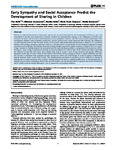Early sympathy and social acceptance predict the development of sharing in children.
| dc.contributor.author | Malti, T | en |
| dc.contributor.author | Gummerum, M | en |
| dc.contributor.author | Keller, M | en |
| dc.contributor.author | Chaparro, MP | en |
| dc.contributor.author | Buchmann, M | en |
| dc.date.accessioned | 2020-10-19T12:08:20Z | |
| dc.date.available | 2020-10-19T12:08:20Z | |
| dc.date.issued | 2012 | en |
| dc.identifier.uri | http://hdl.handle.net/10026.1/16555 | |
| dc.description.abstract |
Sharing is a fascinating activity of the human species and an important basis for the development of fairness, care, and cooperation in human social interaction. Economic research has proposed that sharing, or the willingness to sacrifice own resources for others, has its roots in social emotions such as sympathy. However, only few cross-sectional experiments have investigated children's other-regarding preferences, and the question how social-emotional skills influence the willingness to share valuable resources has not been tested. In the present longitudinal-experimental study, a sample of 175 6-year-old children, their primary caregivers, and their teachers is examined over a 3-year period of time. Data are analyzed by means of growth curve modeling. The findings show that sharing valuable resources strongly increases in children from 6 to 9 years of age. Increases in sharing behavior are associated with the early-developing ability to sympathize with anonymous others. Sharing at 7 years of age is predicted by feelings of social acceptance at 6 years of age. These findings hold after controlling for children's IQ and SES. Girls share more equally than boys at 6 and 7 years of age, however, this gender difference disappears at the age of 9 years. These results indicate that human sharing strongly increases in middle childhood and, that this increase is associated with sympathy towards anonymous others and with feelings of social acceptance. Additionally, sharing develops earlier in girls than in boys. This developmental perspective contributes to new evidence on change in sharing and its social-emotional roots. A better understanding of the factors underlying differences in the development of sharing and pro-social orientations should also provide insights into the development of atypical, anti-social orientations which exhibit social-emotional differences such as aggression and bullying behavior. | en |
| dc.format.extent | e52017 - ? | en |
| dc.language | eng | en |
| dc.language.iso | eng | en |
| dc.subject | Adolescent | en |
| dc.subject | Child | en |
| dc.subject | Child Development | en |
| dc.subject | Child, Preschool | en |
| dc.subject | Female | en |
| dc.subject | Humans | en |
| dc.subject | Male | en |
| dc.subject | Psychological Distance | en |
| dc.subject | Social Behavior | en |
| dc.title | Early sympathy and social acceptance predict the development of sharing in children. | en |
| dc.type | Journal Article | |
| plymouth.author-url | https://www.ncbi.nlm.nih.gov/pubmed/23272197 | en |
| plymouth.issue | 12 | en |
| plymouth.volume | 7 | en |
| plymouth.publication-status | Published | en |
| plymouth.journal | PLoS One | en |
| dc.identifier.doi | 10.1371/journal.pone.0052017 | en |
| plymouth.organisational-group | /Plymouth | |
| plymouth.organisational-group | /Plymouth/REF 2021 Researchers by UoA | |
| plymouth.organisational-group | /Plymouth/REF 2021 Researchers by UoA/UoA04 Psychology, Psychiatry and Neuroscience | |
| plymouth.organisational-group | /Plymouth/Research Groups | |
| plymouth.organisational-group | /Plymouth/Research Groups/Centre for Brain, Cognition and Behaviour (CBCB) | |
| plymouth.organisational-group | /Plymouth/Research Groups/Centre for Brain, Cognition and Behaviour (CBCB)/Cognition | |
| dc.publisher.place | United States | en |
| dcterms.dateAccepted | 2012-11-09 | en |
| dc.identifier.eissn | 1932-6203 | en |
| dc.rights.embargoperiod | Not known | en |
| rioxxterms.versionofrecord | 10.1371/journal.pone.0052017 | en |
| rioxxterms.licenseref.uri | http://www.rioxx.net/licenses/all-rights-reserved | en |
| rioxxterms.licenseref.startdate | 2012 | en |
| rioxxterms.type | Journal Article/Review | en |


